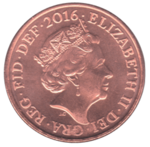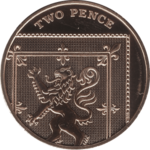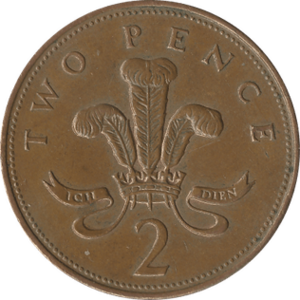Two pence (British decimal coin) facts for kids
| United Kingdom (UK) | |
| Value | £0.02 |
|---|---|
| Mass | 7.12 g |
| Diameter | 25.9 mm |
| Thickness | |
| Edge | Plain |
| Composition |
|
| Years of minting | 1971–present |
| Obverse | |
 |
|
| Design | Queen Elizabeth II |
| Designer | Jody Clark |
| Design date | 2015 |
| Reverse | |
 |
|
| Design | Segment of the Royal Shield |
| Designer | Matthew Dent |
| Design date | 2008 |
The British two pence coin, often called 2p, is a coin from the United Kingdom. It's worth two hundredths (2⁄100) of a pound. It was first made on February 15, 1971, when British money changed to a decimal system. Since then, the front side (called the obverse) has shown four different pictures of Queen Elizabeth II. In 2008, the back side (called the reverse) changed. It used to show a plume of ostrich feathers, but now it shows part of the Royal Shield.
The two pence coin was first made from bronze. But in 1992, it changed to steel covered in copper. As of 2014, there were about 6.55 billion 2p coins being used, which is worth £131 million.
Two pence coins are considered legal tender for amounts up to 20p. This means if you owe someone money, they have to accept 2p coins for debts up to 20p. However, this rule usually doesn't matter for everyday shopping. Shops can choose what kind of payment they accept.
Contents
What Are 2p Coins Made Of?
From 1971 until 1992, two pence coins were made from bronze. In 1992, the material changed to steel with a thin layer of copper on top. This change happened because the price of copper, which was used to make bronze, was going up. Both bronze and copper-plated steel 2p coins were made in 1992.
By 2006, the older bronze coins (which were 97% copper) actually contained about 3p worth of copper. The Royal Mint, which makes the coins, warned people that it's against the law to tamper with or melt down coins in the UK.
How the 2p Coin Looks
Coins have two main sides: the front (obverse) and the back (reverse).
The Back (Reverse) Design
The first design for the back of the 2p coin was created by Christopher Ironside. It was used from 1971 to 2008. This design showed the Badge of the Prince of Wales. This badge is a plume of ostrich feathers inside a coronet (a small crown). Below it was the German motto ICH DIEN, which means "I serve."
The number "2" was placed below the badge. Above it, the coin said either NEW PENCE (from 1971 to 1981) or TWO PENCE (from 1982 onwards). A few coins made in 1983 accidentally still had the "New Pence" wording.
In 2005, the Royal Mint held a competition to find new designs for the back of many British coins. Matthew Dent won this competition in 2008. His designs were slowly introduced onto coins starting in mid-2008.
Matthew Dent's designs for the 1p, 2p, 5p, 10p, 20p, and 50p coins show different parts of the Royal Shield. When you put all these coins together, they form the complete shield. The redesigned 2p coin shows the second quarter of the shield. This part features the Lion Rampant, which is a lion standing on its hind legs, from the Royal Banner of Scotland. The words TWO PENCE are written above it.
When the coins were redesigned in 2008, the small dots around the edge of both sides of the coin, called "beading," were removed.
The Front (Obverse) Design
So far, five different designs have been used on the front of the 2p coin. These include four different portraits of the Queen and the removal of the beaded border in 2008. On all these coins, the words ELIZABETH II D.G.REG.F.D. are shown, followed by the year the coin was made.
Here are the different portraits of the Queen used on the 2p coin:
- 1971-1984: The first portrait was by Arnold Machin. In this picture, Queen Elizabeth II wears the 'Girls of Great Britain and Ireland' Tiara.
- 1985-1997: The second portrait was by Raphael Maklouf. Here, the Queen wears the George IV State Diadem. It was during this period, in 1992, that the coin's metal changed from bronze to copper-plated steel.
- 1998-2015: The third portrait was by Ian Rank-Broadley. This design also shows the Queen wearing the tiara. You can see the small letters IRB below the portrait, which are the designer's initials.
- 2015-Present: Since June 2015, coins with a portrait by Jody Clark have been in use.
How Many 2p Coins Are Made?
The table below shows how many two pence coins have been made for general use each year.
| Year | Number minted | Composition | Portrait | Reverse |
|---|---|---|---|---|
| 1971 | 1,454,856,250 | Bronze | Machin | Ironside |
| 1972 | In sets only | |||
| 1973 | In sets only | |||
| 1974 | In sets only | |||
| 1975 | 145,545,000 | |||
| 1976 | 181,379,000 | |||
| 1977 | 109,281,000 | |||
| 1978 | 189,658,000 | |||
| 1979 | 260,200,000 | |||
| 1980 | 408,527,000 | |||
| 1981 | 353,191,000 | |||
| 1982 | In sets only | |||
| 1983 | In sets only | |||
| 1984 | In sets only | |||
| 1985 | 107,113,000 | Maklouf | ||
| 1986 | 168,967,500 | |||
| 1987 | 218,100,750 | |||
| 1988 | 419,889,000 | |||
| 1989 | 359,226,000 | |||
| 1990 | 204,499,700 | |||
| 1991 | 86,625,250 | |||
| 1992 | 102,247,000 | |||
| 1993 | 235,674,000 | |||
| 1994 | 531,628,000 | |||
| 1995 | 124,482,000 | |||
| 1996 | 296,278,000 | |||
| 1997 | 496,116,000 | |||
| 1998 | 98,676,000 | Rank-Broadley | ||
| 115,154,000 | Copper-plated steel | |||
| 1999 | 353,816,000 | |||
| 2000 | 563,659,000 | |||
| 2001 | 551,880,000 | |||
| 2002 | 168,556,000 | |||
| 2003 | 260,225,000 | |||
| 2004 | 356,396,000 | |||
| 2005 | 280,396,000 | |||
| 2006 | 170,637,000 | |||
| 2007 | 254,500,000 | |||
| 2008 | 10,600,000 | |||
| 241,679,000 | Dent | |||
| 2009 | 150,500,500 | |||
| 2010 | 99,600,000 | |||
| 2011 | 144,300,000 | |||
| 2012 | 67,800,000 | |||
| 2013 | 40,600,000 | |||
| 2014 | 247,600,020 | |||
| 2015 | 85,900,000 | |||
| 2015 | 139,200,000 | Clark | ||
| 2016 | 185,600,000 | |||
| 2017 | 16,600,000 | |||
| 2018 | 0 | |||
| 2019 | 0 | |||
| 2020 | 0 | |||
| 2021 | 117,700,000 | |||
| 2022 | 0 |
Sometimes, coins are only made as part of special collector sets. If the table says "In sets only" or "0" for a year, it means no 2p coins were made for general use that year, but they might be found in these special sets.


